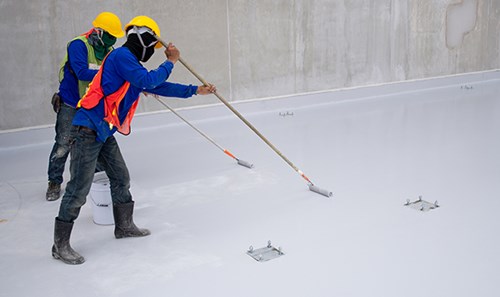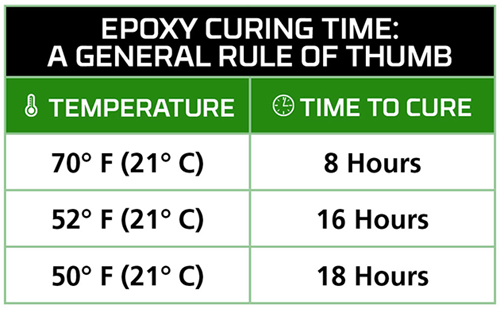 Epoxy coatings are important for protecting surfaces from various types of damage—from scratches and abrasion to chemicals and more. Although they can be used at cold temperatures, epoxy coatings must be handled and applied with special techniques adapted to the environment at hand.
Epoxy coatings are important for protecting surfaces from various types of damage—from scratches and abrasion to chemicals and more. Although they can be used at cold temperatures, epoxy coatings must be handled and applied with special techniques adapted to the environment at hand.
Mixing an epoxy resin and a hardener together creates a chemical reaction that produces heat. Both the ambient temperature and the temperature of the concrete affect the epoxy’s rate of reaction and degree of cure. If the coating is applied in cooler temperatures, the epoxy may appear sufficiently hardened, but it will not reach a complete cure or achieve its designed physical properties—ultimately leading it to fail prematurely.
Five tips to keep in mind when applying epoxy coatings in cold weather:
1. Warm the Resin & Hardener Before Use
To ensure the chemical reaction is off to a good start and promote optimal curing, warm the resin and hardener with heat lamps or keep them in a heated environment before use. If the epoxy is being used outdoors, a small, portable epoxy storage box can be built out of rigid sheets of foil-backed insulation, with a regular light bulb or an electric heating pad inside, to maintain a temperature of 70-90° F (21-32° C). This method will keep the warm resin and hardener near the work area and prevent the material from cooling off before it can be mixed and applied.
In addition, the area must be kept heated during the epoxy’s full cure time. If the manufacturer’s literature says that the epoxy cure time is eight hours, assume that means eight hours at 70° F (21° C). If the substrate and environment temperature are lower, the cure time will be longer. As a general rule of thumb, for every 18° F drop in temperature below 70° F, the cure time doubles.  So, if the substrate and environment can only be heated to 50° F, the epoxy will require about 18 hours to cure. Keep in mind that most epoxies, unless specifically formulated for cold-weather use, will never fully cure at temperatures below 50° F.
So, if the substrate and environment can only be heated to 50° F, the epoxy will require about 18 hours to cure. Keep in mind that most epoxies, unless specifically formulated for cold-weather use, will never fully cure at temperatures below 50° F.
Except those specifically formulated and labeled with the ability to cure at low temperatures, epoxy coatings are typically best suited for application at temperatures above 50°F (10°C). However, the ideal application temperature is dependent on the product. To learn the minimum recommended application temperature for the product being applied, applicators should refer to the epoxy coating literature or contact the manufacturer. They should then ensure the coating environment stays at or above that temperature during application and for the entire curing period.
Why Temperature is Important
When epoxy resin and hardener are mixed together, a chemical reaction begins. The temperature of the surroundings, the concrete to be coated, and the epoxy mixture will affect the rate or speed of the epoxy chemical reaction, as well as the degree of cure. Warmer temperatures will accelerate the chemical reaction, while colder temperatures slow the reaction down. Both will directly affect the cure time and the physical properties of the epoxy.
In addition, the temperature has an effect on the handling properties of epoxy resin. As the temperature drops, epoxy becomes much thicker and will not flow properly. This means that it is much more difficult to measure and mix the epoxy resin and hardener in cold weather, which can lead to incomplete mixing and a greater risk of coating failure. Cold, thick epoxy and a cold substrate also cause application issues, such as an uneven appearance and air bubbles in the finished product.
2. Ensure Proper Mix Ratio
It’s important to ensure that the resin and hardener are used in the proper mix ratio. Mixing Part A and Part B off ratio can seriously compromise the epoxy’s ability to cure properly and achieve ultimate strength. The best practice is to mix the full kit of epoxy, and do not attempt to break it down and mix smaller volumes.
The proper mix ratio depends on the product—another reason to carefully read the instructions before use. Many epoxy coatings have a mix ratio of 1:1, which means one part by volume of Part A (the epoxy resin) to one part by volume of Part B (the curing agent). However, mix ratios of 2:1, 3:1 and 4:1 are also common.
In some cases, the defects caused by off-ratio mixing are visually evident during application. The most apparent evidence of an off-ratio mix is an epoxy coating that does not cure—the chemical reaction does not run to completion and, as a result, the coating stays soft and tacky. Conversely, an epoxy mixed at the wrong ratio could react too quickly, causing cracks in the cured coating.
Other times, an epoxy coating mixed off-ratio may appear to have cured properly and not be visually different from a coating mixed at the proper ratio. However, the coating’s flexibility, chemical resistance, water-resistance, and hardness may all be adversely affected by the off-ratio mix. Depending on the service environment of the coating, these defects may not be immediately noticeable. For example, an epoxy floor coating mixed off-ratio could appear to be fine at first but, after the floor is in use, the coating could be easily scratched, discolor upon exposure to water or chemicals, or delaminate.
3. Mix Resin & Hardener Thoroughly
The resin and hardener should be mixed together thoroughly. As always, pre-mix Parts A and B before combining. Then, mix the two parts together for approximately two minutes at a minimum, with a slow speed drill and paddle mixer. Never mix by hand!
Scrape the sides and bottom of the container during mixing. A smaller volume mixing vessel will improve the chemical activity because the limited surface area will not dissipate heat produced by the chemical reaction. For example, mix a two-gallon unit of epoxy in a three-gallon container.
4. Warm Surface & Environment to Fullest Extent
When applied to a warmer surface, the epoxy will thin out and flow much smoother and penetrate better, which will result in a stronger bond. Warming outdoor areas that will be coated can be done by constructing curing tents around the area and using portable heaters or heat lamps. Never use unvented open-flame heat sources, such as salamanders or catalytic heaters. The exhaust gases for these types of heaters can contaminate the surface, elevate moisture, and CO2 levels caused by the exhaust will affect the epoxy’s cure and ultimately lead to coating failure. Catalytic heaters do not appear to pose a problem unless used in a confined space, such as a curing tent or box.
5. Carefully Prepare Surface Before Re-Application
When coating in colder temperatures, the slower cure can result in the formation of an amine blush on the epoxy surface. The blush feels like a waxy film on the surface of the cured epoxy. If a second coat is necessary, before applying the second coat, immediately wash the surface with warm water using a 3-M Scotchbrite pad. Before the water evaporates, dry the surface with clean, lint-free towels and sand any remaining glossy areas with medium-grit sandpaper. Ensure all sanding residue is removed before applying the coating.
Before you begin any project, it’s important to understand the effects of applying epoxy in cold weather so you can properly prepare. By implementing these steps into your preparation and application process, you will ensure a successful outcome.
About the Author
Jennifer Crisman is director of marketing services at Euclid Chemical. A 20-plus-year industry veteran, Crisman manages marketing communications initiatives for Euclid Chemical’s line of admixtures, fiber reinforcement, concrete repair products, flooring materials and decorative concrete systems.